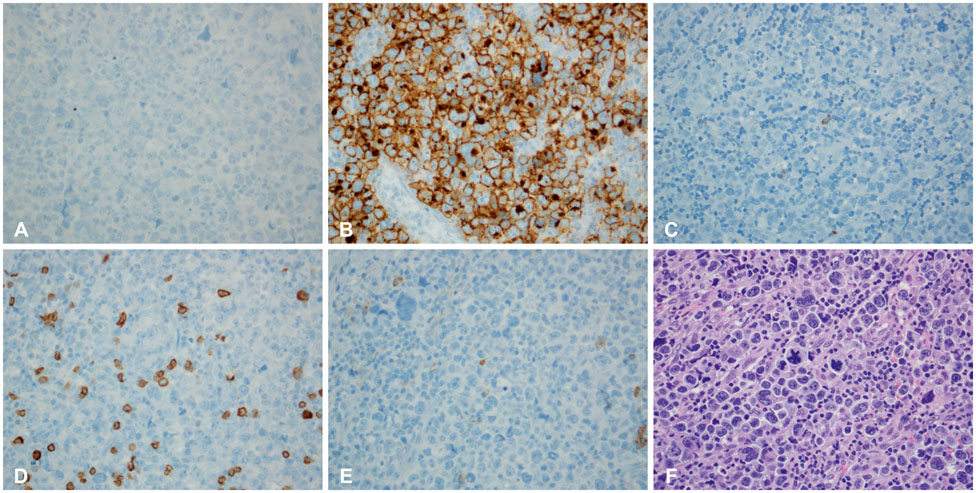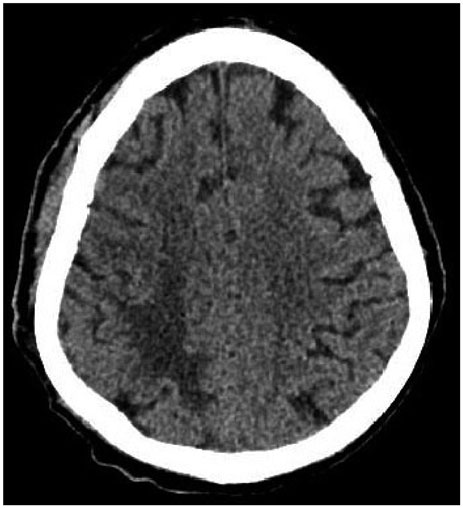Brain Tumor Res Treat.
2017 Apr;5(1):45-48. 10.14791/btrt.2017.5.1.45.
Cutaneous Anaplastic Large T-Cell Lymphoma with Invasion of the Central Nervous System: A Case Report
- Affiliations
-
- 1Department of Neurosurgery, Konyang University Hospital, Daejeon, Korea. greatkahn@kyuh.ac.kr
- KMID: 2378306
- DOI: http://doi.org/10.14791/btrt.2017.5.1.45
Abstract
- Anaplastic large T-cell lymphoma (ALCL) encompasses different clinical entities that can be aggressive or localized. Scalp anaplastic lymphoma kinase (ALK)-negative ALCL is considered a localized lymphoma, and usually extends to the regional lymph nodes; intracranial invasion is rare. A 74-year-old woman was diagnosed with scalp ALK-negative ALCL, but did not exhibit invasion of the lymph nodes. Computed tomography and magnetic resonance imaging revealed intracranial masses with bony erosions. We treated the patient using CHOP chemotherapy and achieved short-term regression of the scalp and intracranial lesions. However, the patients ultimately died of pneumonia during the pancytopenic period. Therefore, caution must be exercised when treating scalp ALK-negative ALCL with intracranial invasion.
Keyword
MeSH Terms
Figure
Reference
-
1. Stein H, Mason DY, Gerdes J, et al. The expression of the Hodgkin's disease associated antigen Ki-1 in reactive and neoplastic lymphoid tissue: evidence that Reed-Sternberg cells and histiocytic malignancies are derived from activated lymphoid cells. Blood. 1985; 66:848–858.
Article2. Medeiros LJ, Elenitoba-Johnson KS. Anaplastic large cell lymphoma. Am J Clin Pathol. 2007; 127:707–722.
Article3. Savage KJ, Harris NL, Vose JM, et al. ALK- anaplastic large-cell lymphoma is clinically and immunophenotypically different from both ALK+ ALCL and peripheral T-cell lymphoma, not otherwise specified: report from the International Peripheral T-Cell Lymphoma Project. Blood. 2008; 111:5496–5504.
Article4. Kim MY, Kim SM, Chung SY, Park MS. Dural marginal zone lymphoma confused with meningioma en plaque. J Korean Neurosurg Soc. 2007; 42:220–223.5. Yoon SH, Paek SH, Park SH, Kim DG, Jung HW. Non-Hodgkin lymphoma of the cranial vault with retrobulbar metastasis mimicking a subacute subdural hematoma: case report. J Neurosurg. 2008; 108:1018–1020.
Article6. Sacho RH, Kogels M, du Plessis D, Jowitt S, Josan VA. Primary diffuse large B-cell central nervous system lymphoma presenting as an acute space-occupying subdural mass. J Neurosurg. 2010; 113:384–387.
Article7. Martin J, Ramesh A, Kamaludeen M, Udhaya , Ganesh K, Martin JJ. Primary non-Hodgkin's lymphoma of the scalp and cranial vault. Case Rep Neurol Med. 2012; 2012:616813.
Article8. Yeung CY, Hong KT, Chiang CP, Chen YH, Ma HI, Tsai TH. Anaplastic lymphoma kinase-negative anaplastic large cell lymphoma manifesting as a scalp hematoma after an acute head injury-a case report and literature review. World Neurosurg. 2016; 88:688.e13–688.e16.
- Full Text Links
- Actions
-
Cited
- CITED
-
- Close
- Share
- Similar articles
-
- Dermatofibroma in Patient with Relapsing Primary Cutaneous Anaplastic Large Cell Lymphoma
- A Case of Multiple Cranial Neuropathies Caused by Anaplastic Lymphoma Kinase-Negative Anaplastic Large Cell Lymphoma
- A Case of Primary Cutaneous Anaplastic Large Cell Lymphoma on the Dorsum of the Hand
- A Case of Multifocal Primary Cutaneous Anaplastic Large Cell Lymphoma Managed without Surgical Treatment
- Primary Cutaneous CD30+ Anaplastic Large Cell Lymphoma That Developed after Lymphomatoid Papulosis




